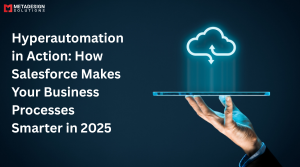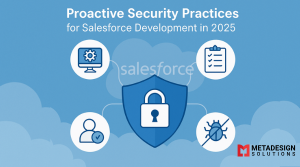The Salesforce Spring ’25 release is here, and it brings meaningful changes across the board. From core platform improvements to fresh tools for automation, analytics, and user experience, this release is stacked with updates that admins, developers, and business users will actually use.
Whether you’re working as a solo Salesforce Admin in India or you’re part of a Salesforce CRM development company, these updates help you build smarter, automate faster, and deliver a more streamlined experience to end users.
This in-depth breakdown of the Salesforce Spring ’25 highlights will guide you through the most impactful changes — categorized by user roles — so you can skip the fluff and get straight to implementation.
For Salesforce Admins: Clean Control, Real Flexibility
Spring ’25 is a big win for admins who want less manual overhead and more configuration power without code. Here are the top features for admins:
1. Dynamic Forms Expansion for Standard Objects
Dynamic Forms are now supported for more standard objects, including Case and Lead. This gives admins the power to create flexible, user-friendly page layouts without touching a line of code. You can conditionally display fields based on record data, making record pages less cluttered and more responsive to user needs.
Why it matters: As a Salesforce Admin in India managing growing user teams, reducing visual noise in record pages can massively improve adoption and data quality.
Ready to Level Up with Spring '25?
Connect with us to integrate the latest Salesforce features seamlessly into your workflow. Let’s talk!
2. Record Types in Permission Sets
One of the most-requested features is finally here: the ability to assign Record Types through Permission Sets. This means admins no longer have to rely on Profile-based access, making user and permission management much more modular and scalable.
Pro tip: Start auditing your Profiles now to migrate logic to Permission Sets gradually — a best practice Salesforce has been nudging everyone toward.
3. Enhanced Report Filter UI
Reports are getting a user experience upgrade with an improved filter interface. Admins and end users alike will benefit from easier multi-filter logic, dropdowns, and a more intuitive layout when customizing reports.
4. Flow Builder Updates
Screen Flows now support collapsible sections, multi-column layouts, and improved error handling. These additions let you build more user-friendly, enterprise-grade flows without writing custom components.
Bonus: Flow Trigger Explorer now shows which triggers fire on record changes — finally removing the guesswork from debugging Flow order of execution.
For Developers: Better Tools, Modern Standards
Spring ’25 continues Salesforce’s push toward a more modern development experience. If you’re building custom apps, components, or integrations, these features are for you.
1. Apex LSP (Language Server Protocol) Enhancements
Salesforce has upgraded Salesforce Apex support in VS Code with better autocomplete, inline documentation, and refactoring tools. These enhancements reduce errors, speed up coding, and help devs build more confidently.
Why it matters: If you’re a dev in a Salesforce consulting services team, LSP improvements help ship cleaner code, faster.
2. Custom LWC in Email Templates
Developers can now embed custom Lightning Web Components in Email Templates. This opens the door to highly personalized, dynamic emails that go way beyond what was previously possible.
Use case: A B2B business could show a real-time product quote or customer-specific service metrics inside an email — built completely within Salesforce.
3. Expanded GraphQL Beta
GraphQL support continues to grow, offering faster, more efficient data queries across Salesforce objects. This is especially useful in front-end apps that need to minimize API calls and display data in custom UI.
Hot tip: If you haven’t explored GraphQL in Salesforce yet, now is a great time to prototype lightweight data apps.
4. New DevOps Center Features
The DevOps Center, still gaining traction since GA, now includes better CI/CD integration and richer metadata tracking. This helps teams manage releases, deployments, and changes more efficiently across sandboxes and environments.
For Business Teams: Productivity and Insights
Business users and customer-facing teams won’t be left out of this release. Spring ’25 brings several enhancements that support better decision-making, faster work, and smarter customer interactions.
1. Einstein Conversation Insights Expansion
Salesforce has added support for analyzing video calls — not just voice — with Einstein Conversation Insights. Now, sales managers can review video interactions for keywords, competitor mentions, and rep talk time.
Impact: This gives managers a 360° view of sales calls and helps improve training and performance tracking.
2. Improved Calendar and Scheduling in Sales Cloud
Sales reps can now manage schedules more intuitively with new calendar views, appointment booking logic, and better mobile sync. Less toggling between tabs, more time selling.
3. Salesforce Maps: Smarter Territory Planning
Territory Planning in Salesforce Maps is now more intelligent, allowing for complex logic and metrics to define territory boundaries. This is a big help for enterprises with field teams across large geographies.
4. Actionable Intelligence in Dashboards
Dashboards now support interactive filters, meaning users can apply filter logic right from the dashboard view. It’s easier than ever for execs and managers to explore data without building new reports.
Cross-Functional Enhancements Worth Noting
Some of the most impactful updates apply to multiple roles, and they’re worth knowing regardless of your title.
1. User Access Policies (Beta)
Admins and security teams can now define user access policies to automate onboarding and offboarding tasks. Think of it as an “if-then” rules engine for provisioning users based on role, department, or other criteria.
Great for: Large orgs or Salesforce Admins in India managing users across multiple business units.
2. Data Cloud (formerly Genie) Expansion
Data Cloud is now better integrated across the platform, letting you unify customer profiles and feed that data into Flows, Marketing Cloud, and Einstein. It’s not just for big corporations anymore — mid-market teams can start leveraging it too.
3. Slack + Salesforce Enhancements
Deeper Salesforce integration in Slack now supports automated workflows, dynamic channel creation based on CRM events, and conversational case creation. If your team lives in Slack, this keeps work flowing without constant context-switching.
What This Means for Salesforce Admins in India
If you’re a Salesforce Admin in India, the Spring ’25 release is a reminder that Salesforce is investing heavily in admin-first tooling. Dynamic Forms, Permission Set enhancements, and Flow improvements are all designed to make your work smoother, especially if you’re managing multiple business processes with limited developer support.
India’s Salesforce talent market continues to grow, and with more companies adopting Salesforce locally, admins are expected to deliver fast results and clean configurations. These new tools let you do just that — with less reliance on devs.
Why This Matters for Salesforce Consulting Services
For teams offering Salesforce consulting services, the Spring ’25 release brings opportunities to deliver higher-value solutions:
- Use Dynamic Forms and Flow updates to streamline client onboarding processes
- Embed custom LWC in email for marketing clients needing high personalization
- Leverage Einstein and Maps for smarter sales strategies
- Guide clients in transitioning to Permission Set-based access control
Also, DevOps Center and GraphQL support give consultants an edge when building scalable and modern deployments.
Whether you’re working with startups or enterprises, these features can turn into strategic wins for your clients.
Final Thoughts
The Salesforce Spring ’25 highlights show Salesforce is continuing its shift toward flexibility, low-code power, and smarter automation. The platform is giving more autonomy to admins, better tools to devs, and real-time insights to business users.
Don’t wait to explore these updates. Try them in a sandbox, check out the new features in Setup, and start building prototypes to show your team or clients the value.
Want help implementing these updates in your org? Consider working with a certified Salesforce consulting partner who can map your use case to the new tools and get you ahead of the curve.
Related Hashtags:
#Salesforce #Spring25 #SalesforceRelease #CRM #SalesforceAdmins #SalesforceDevelopers #CloudComputing #DigitalTransformation #TechForBusiness #SalesforceConsulting



